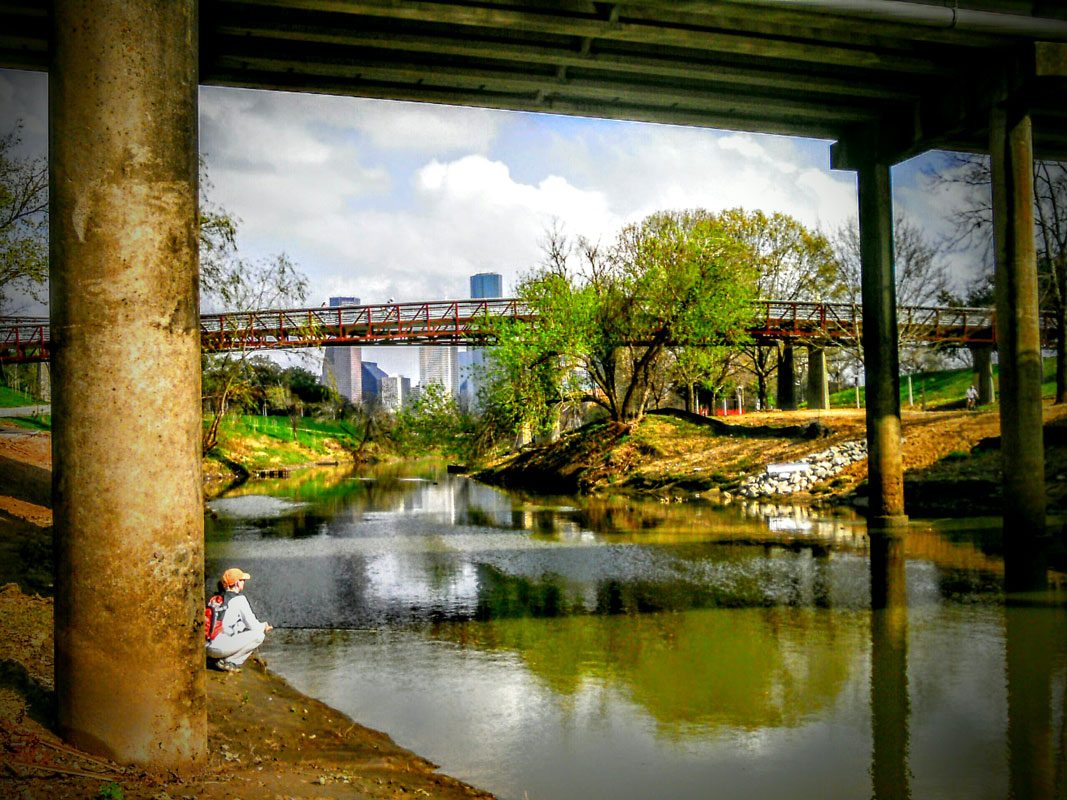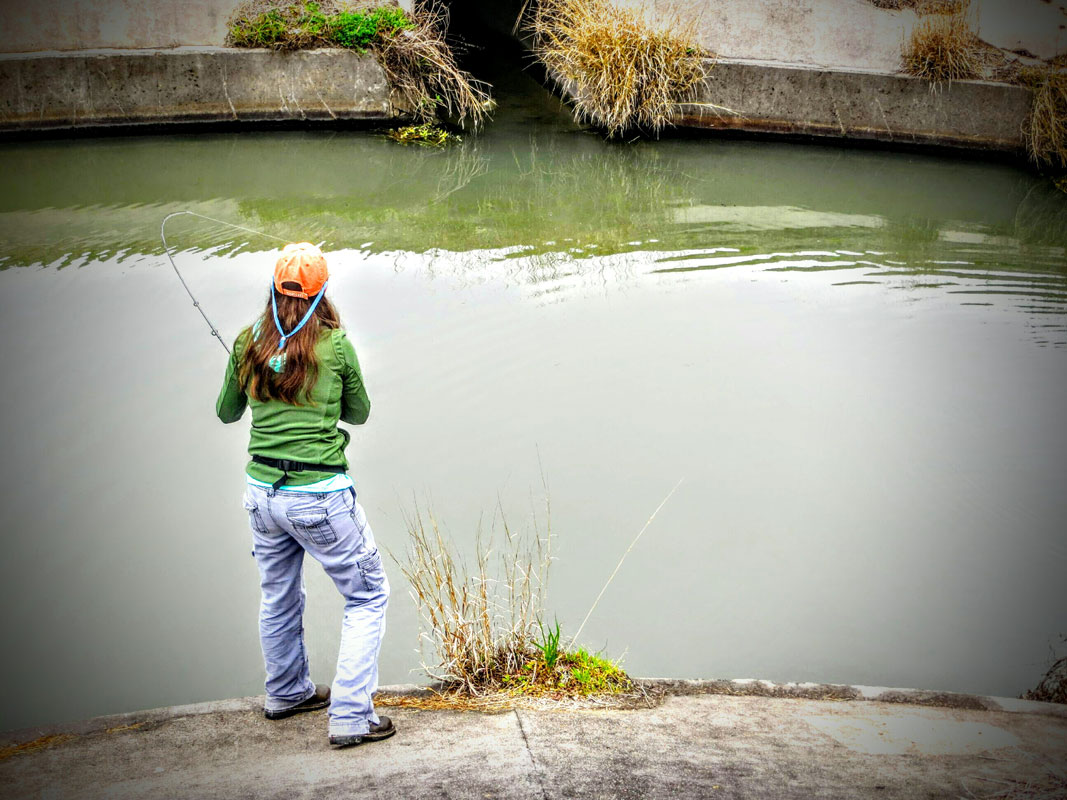They said, “it’s only trash.”
They said, “you’ll never catch anything in there.”
They said, “it’s not worth your time.”

However, I saw things very differently from the moment I found my first ditch. I walked down a path behind the home where I was living at the time, only to find a fork in a bayou, and what I saw then changed me and started my journey into trashy waters. What I saw was a fish the length of my body. Not knowing what it was at the time, I started doing research on what fish, that large, could swim so far up into the middle of nowhere. I went back daily to watch him, observe him, even throw a fly at him, but never did catch him.
I was raised by traveling, classical musicians. My father has been a dedicated, lifelong fly fisherman. He made all of our rods, tied all of our flies and taught me the techniques of this magical sport. I realized I had come full circle in my heart when I saw that great bend in the bayou. I fly fished with my father at a very young age in Northern Idaho, spent many of my summers fishing on the Yellowstone River in Wyoming and Montana, the waters of the Olympic Peninsula of Washington and the crystal clear salt of Florida’s big waters. We traveled all over the country every summer to orchestras in which my parents performed. My father tells me that I spent most of those days, if not all, gazing into the water and catching all of the trout for the family fish fry. He still says that I will these fish out of the water. What those early childhood experiences gave me is the pure joy and freedom of exploring the unknown.

For some, learning something new can be scary. For me, it’s the journey of a lifetime. Driving around a huge city, exhausted after assisting in surgery all day, crossing bridge after bridge, I started wondering about what flowed beneath. These forgotten waters, it ends up, gave me my way out; they provided the destination, the desire and, in the end, more faith in my fly fishing skills, (fishing these challenging “nasty” waters) than I ever thought possible.
I’d occasionally see other folks walking with rods, but never any fish; so I took the chance to explore every day I could. What better way to avoid a two hour drive home in hideous traffic than to pull off the side of the road, any road, and fly fish like the wind. Nothing really stood in my way.
So this is where I began my journey, in a depressed part of the city noted to be in “the ghetto” of South Houston. Right in the middle of 6 lanes of traffic exists the perfect ditch. After 3 years of fishing these ditches, I had neighborhood kids follow me, peppering me with questions; “What are you gonna catch today? What’s in there? What is that you’re fishing with? What in the heck is that kind of rod?” I’ve been recognized by friends, friends of friends, coworkers and patients by fishing these ditches and yet I still never see a single soul fishing where I fish.
I’ve caught over 20 different species out of these prized trashy places, fallen countless times down 20 foot embankments, gone swimming after my fly boxes and fly rods in the cold, brisk, dirty, smelly waters, but at the end of the day, these are precious beautiful places to me. At any given time, you get to fight with gar, largemouth bass, trout, redfish, tilapia, catfish, monster carp, crappie, perch, bluegill or other species. What more could a fly gal want? Some of these bayous and ditches produce such large fish that I just sit on the side of the embankment for an entire day studying what they are, what they eat, when they eat and what makes them come to the surface. During this time, the wind blowing through my hair, the smell of sunscreen and bug spray never leave my nose, and yet I go back time and time again.
The waters are murky and you have to be careful of rainfall in any part of the city. When rain falls in one part of the city, it can mean a flood is coming your way. The hard part was finding what worked. After going to countless fly shops, I ended up making everything up on my own anyway. If one fly worked, I would buy more. Once I understood the patterns that worked, I tied my own flies. I continued to do this daily, nightly, on the weekends, after work, before work, during floods, storms, ice and rain. Every weekend, evening and at the break of dawn, my favorite fishing trips were to these ditches, bayous and trashy waters. It took me a few times to hook my first fish, but after the first pull, the sound of my own screaming drag and knowing that a decent size gar was on the end of my line, I knew I had found my way. Catching my first on my own fly - priceless. Hooking a larger fish with another one of my own flies the next day - profound.
People still ask me what made me go look in the ditch in the first place. I can tell you that it wasn’t the old man drinking a beer sitting next to the bayou that got my attention. It was the pure raw element of finding my own way in a huge city back to the only perfect place I’ve ever truly known, fly fishing. Fishing in even the trashiest of places became MY home waters. I have spent many a day under bridges hiding out from serious lightning and thunderstorms, storms that take your breath away, only to emerge 8 hours later with a great story, colors on fish that I’ve never seen or could even describe and a beautiful time outside and also within myself. These inner city journeys can be rough. There are snakes, killer red ants, mosquitoes the size of your head, mud that is never stable, water that is always murky and alligators lurking. I’ve never been afraid of these waters and still am not. To find glory isn’t there always a risk? I have learned more, seen more, felt more and lived more in my hours of casting along the bayous of this huge city than anyone I know.
I was never taught how to fish conventionally. My pop gave me a fly rod one day at around 5 years of age and said, “Go play out back instead of playing in the traffic.”
It’s ironic now that as an adult I play in 6 lanes of traffic to find fish; my love of this sport produces an inner peace and grace.

So I hover and take position along the curving banks and begin the soothing, rhythmic, tick-tock motion of fly fishing. Throwing loops with the whistling sound of the fly over my head, the breeze carrying the sounds of honking cars, ducks flying by and frogs chirping loudly, to have my line lie down into the rippling water of my place of peace. What comes next is even better.
They said it was dirty. They said it was nasty. They said it was just “trash.”
What I’ve found is a lifetime journey of fly fishing where no one ever goes, never tries and never even thinks to venture into.
So when you hear the whistle of my back cast, see a gal and her fly rod heading down a steep embankment, you’ll know it’s me on another journey, down to the deep, sticky, dirty and nasty ditch. For in the trash, the beautiful trash, I know no one else has found beauty like I have.

As for that first fish I saw over 3 years ago in the bend of the bayou, where I felt my heart pound so hard that I almost fainted, I remember the clouds were so gorgeous over my head and the wind just perfect against my sun-rosy cheeks; this I will always continue searching for, try for. While I feel my way through, hiking and falling into the smelly, dirty, trashy waters, the excitement of the unknown remain MY place - the most beautiful, thick with fish, rippling with glory places I’ve ever known. My own big trash can filled with some of the most wonderful memories anyone could ask for.
This is my trash.
